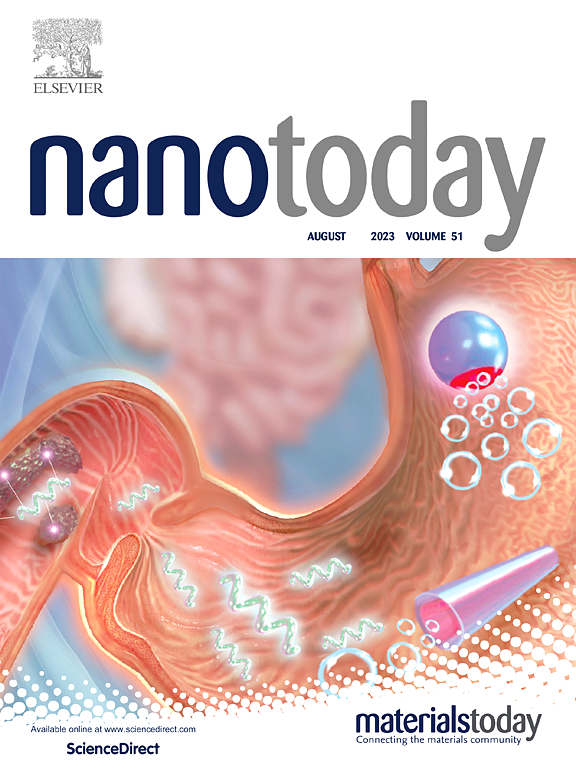Revolutionizing role of magnetic field-guided MnFe2O4@ZIF-8@retinoic acid in DUCA conduits for inflammation inhibition and peripheral nerve regeneration
IF 10.9
1区 材料科学
Q1 CHEMISTRY, MULTIDISCIPLINARY
引用次数: 0
Abstract
Neuroma formation following the repair of nerve injuries exceeding 0.9 cm in length severely impedes functional recovery. To overcome this challenge, we engineered magnetically responsive core-shell nanoparticles (MnFe2O4@ZIF-8@Retinoic acid, MFZR; 90–360 nm) to guide regeneration within a decellularized umbilical cord artery (DUCA) conduit. We investigated the synergistic effect of MFZR under an external magnetic field (MF) on Schwann cell behavior in vitro and on sciatic nerve repair in a rat model. Under MF exposure, MFZR significantly enhanced Schwann cell migration, alignment, and elongation on DUCA conduits. In-vivo, the MFZR+MF combination potently promoted functional recovery, as measured by the sciatic functional index, muscle compound action potential, and nerve conduction velocity, without inducing DUCA-related inflammation. Histological analysis demonstrated robust regeneration, characterized by increased axon diameter, an improved G-ratio, and elevated expression of S100 and NF-200. This regeneration was facilitated by a healing-promoting M2 macrophage polarization at the injury site. Critically, the strategy exhibited no systemic toxicity. These findings establish that magnetically guided MFZR effectively prevents neuroma in the DUCA conduits, orchestrates a pro-regenerative microenvironment, and achieves significant functional recovery, offering a promising translatable strategy for nerve repair.
革命性的作用磁场引导MnFe2O4@ZIF-8@维甲酸在DUCA导管炎症抑制和周围神经再生
长度超过0.9 cm的神经损伤修复后形成的神经瘤严重阻碍功能恢复。为了克服这一挑战,我们设计了磁响应核壳纳米颗粒(MnFe2O4@ZIF-8@维甲酸,MFZR; 90-360 nm)来引导去细胞脐带动脉(DUCA)导管内的再生。我们研究了外磁场作用下MFZR对体外雪旺细胞行为和大鼠坐骨神经修复的协同作用。在中频暴露下,MFZR显著增强了DUCA导管上雪旺细胞的迁移、排列和伸长。在体内,通过坐骨功能指数、肌肉复合动作电位和神经传导速度测量,MFZR+MF联合有效促进功能恢复,而不会引起duca相关炎症。组织学分析显示再生强劲,其特征是轴突直径增加,g比改善,S100和NF-200表达升高。损伤部位促进愈合的M2巨噬细胞极化促进了这种再生。关键的是,该策略没有表现出系统性毒性。这些发现表明,磁引导MFZR有效地预防了DUCA导管中的神经瘤,协调了一个促进再生的微环境,并实现了显著的功能恢复,为神经修复提供了一种有前途的可翻译策略。
本文章由计算机程序翻译,如有差异,请以英文原文为准。
求助全文
约1分钟内获得全文
求助全文
来源期刊

Nano Today
工程技术-材料科学:综合
CiteScore
21.50
自引率
3.40%
发文量
305
审稿时长
40 days
期刊介绍:
Nano Today is a journal dedicated to publishing influential and innovative work in the field of nanoscience and technology. It covers a wide range of subject areas including biomaterials, materials chemistry, materials science, chemistry, bioengineering, biochemistry, genetics and molecular biology, engineering, and nanotechnology. The journal considers articles that inform readers about the latest research, breakthroughs, and topical issues in these fields. It provides comprehensive coverage through a mixture of peer-reviewed articles, research news, and information on key developments. Nano Today is abstracted and indexed in Science Citation Index, Ei Compendex, Embase, Scopus, and INSPEC.
 求助内容:
求助内容: 应助结果提醒方式:
应助结果提醒方式:


